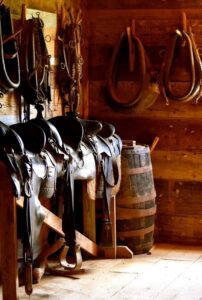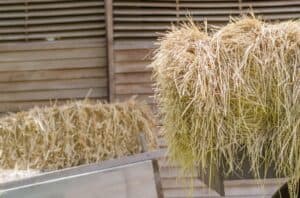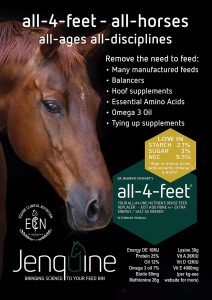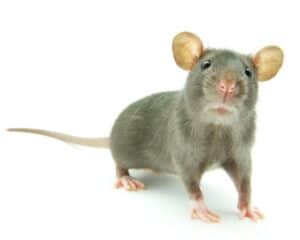Rodents in the Feedroom
Horse feed, hay, bedding, saddles and rugs are very, very
attractive to rodents – ie rats and mice! But there are many
really important reasons why you should not let them into
your tack and feed rooms.
Rat and mice ruin 10 times as much food as they eat.
Contamination with urine, droppings and fur destroys stored
feed. They also chew on rugs, saddle cloths, buildings and
electrical cables – causing fires. They also carry fleas, mites and
ticks as well as diseases such as leptospirosis and salmonella
that affect horses, dogs, humans and other animals.
Rodents are not something you want in your feedroom. But the
first step in the battle to keep your tack and feedrooms
hygienic and rodent-free, is to ‘know your enemy’! Once they
have set up home, rats will occupy a territory within 50 metres
of their nest. They are able to squeeze through gaps as little as
13mm wide, jump about 90cm in height, deposit 45 droppings
a day and the females can produce 70 babies a year. When you
count their children, a single pair of rats can multiply to 15,000
in one year.
They prefer grains and meat but will eat anything from plaster
to soap and dead animals. They are more suspicious than mice
and stay away from traps and poison baits if other food is
around. Mice can do 75 droppings a day and squeeze through
gaps the size of a pencil! They can run up vertical surfaces and
jump 30cm.
Signs you may have rodents include chewed feed bags and
droppings. Sometimes you’ll see or hear them – but for every
rat or mouse you see, there will be 25 more not far away –
usually hiding in the walls, under the floor and in the ceiling.
If you have such a serious infestation that you need to use
poison, it’s really important to understand the risks. Crucially,
you must ensure that birds and other animals do not get
access to the poison. Carefully read the instructions on the pack
and follow them to the letter. Horses, dogs, cats and people
have all been poisoned by rodent baits.
Rodents usually move outside when the weather warms up
and if you follow the steps above, you’ll ruin the chances and
desire to come back in autumn.
If rats continue to be an issue, reach out to your
local department of agriculture or university for
additional recommendations they are usually
very happy to help you with suggestions!
NINE steps to reduce a rat or mouse infestation
IT WOULD be great if we could make every building
rodent-proof, but this is really difficult. However,
there are several steps to reduce and hopefully
prevent rodents infesting your feedroom:
1. Store feed in metal containers with lids
2. Sweep up any feed spills straight away – if
other people use the feedroom, you could post
signs to remind them to do the same.
3. Regularly move feed containers away from the
wall and thoroughly sweep the feed room floor
4. Keep windows and doors closed
5. rugs, bandages and saddle cloths are much
sought after as nesting materials, so store them off
the floor and ideally in rodent-proof containers.
These pieces of equipment are sought after as
bedding material and nesting sites by industrious
rodents.
6. Rodents like to have water nearby to their
nests so do everything you can to prevent water
pooling and keep water and food bowls away from
the feedroom – non-venomous snakes, cats and
terriers are often used for catching rats and mice –
but if their food and water bowls are within the
rodents territory, you might actually be
encouraging them to move in
7. Keep weeds/grass around your buildings really
short; rodents travel along walls and love having
cover
8. Traps can be set along walls were rodents run
and near holes – big advantage is that you can
remove the bodies and stop the chance of nasty
smells if they die behind walls or in the ceiling. One
of the biggest mistakes with traps is not using
enough of them.
9. Poisons can be used, but have many downsides as
you don’t know for sure where they will
end up – many birds and pets are killed due to
eating poisonous baits. They can also be a risk for
children.
DISCLAIMER All content provided in this article is for general use and information only and does not constitute advice or a veterinary opinion. It is not intended as specific medical advice or opinion and should not be relied on in place of consultation with your veterinarian.
More information on equine nutrition is available at www.jenquine.com
Meet the author and PCA’s resident equine nutritionist
Dr Jennifer Helen Stewart
BVSc BSc PhD Dip BEP MRCVS
Equine Veterinarian and Consultant Nutritionist – CEO Jenquine
Dr Jennifer Stewart is an equine veterinarian with over thirty five years’ experience. She is also a consultant nutritionist and has formulated feeds, custom mixes and supplements for leading international horse feed manufacturers in Australia, India, Ireland, Japan, New Zealand, Philippines, South Africa, Thailand, Turkey and the UAE. Dr Stewart is passionate about equine nutrition and its role in the management, treatment and prevention of many equine diseases. She is committed to bringing ‘science to the feed bin’.
Dr Stewart graduated BSc (vet) and BVSc at the University of Sydney. Her research thesis was “Resistance of Equine Strongyles to Benzimidazole Anthelmintics” and her PhD “Studies on Heart and Lung Function in Foals”. She worked at the Universities of North Carolina, Michigan and Florida USA in equine medicine, antibiotics and exercise physiology. Following this was a time spent in Newmarket and Cambridge England, in stud and race track research and practice, before establishing an exclusively equine practice on the Central Coast of NSW Australia. She has been an official veterinarian for the Australian Jockey Club for over 20 years, was one of the team of equine veterinarians for the Sydney 2000 Olympic Games and consultant nutritionist for Mitavite for 10 years.
Dr Stewart has spent over twenty five years working on collaborative research projects into gastrointestinal and exercise physiology with major Universities; lecturing and supervising university and TAFE students; consulting to veterinary practices, trainers, pony clubs, owners, equestrian centres and studs; speaking at seminars in Australia, Middle East, South Africa, Philippines, SE Asia, Hong Kong, Japan, Turkey, India and New Zealand, and writing regularly for equine industry magazines. This experience in research, equine medicine and veterinary practice has given Dr Stewart a deep understanding of the complexities of equine health and performance; growth and development of young horses, and feeding practices for the management and prevention of diseases.
Watch Dr Stewart talk about her first love of horses and why she chose to become a vet in this short clip. Pony Club Australia is grateful for Dr Stewart preparing this laminitis article for our Horse Resource page. Please browse her other articles, blog and resources at Jenquine.



